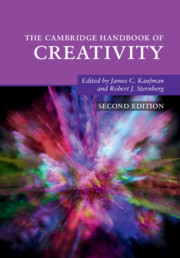Book contents
- The Cambridge Handbook of Creativity
- The Cambridge Handbook of Creativity
- Copyright page
- Dedication
- Contents
- Figures
- Tables
- Contributors
- Foreword
- Acknowledgments
- An Introduction to the Second Edition
- Part I An Introduction to Creativity
- The Nature of Creativity
- Part II Underpinnings of Creativity
- Part III Differential Bases for Creativity
- Part IV Creativity in the World
- Index
- References
The Nature of Creativity
from Part I - An Introduction to Creativity
Published online by Cambridge University Press: 12 April 2019
- The Cambridge Handbook of Creativity
- The Cambridge Handbook of Creativity
- Copyright page
- Dedication
- Contents
- Figures
- Tables
- Contributors
- Foreword
- Acknowledgments
- An Introduction to the Second Edition
- Part I An Introduction to Creativity
- The Nature of Creativity
- Part II Underpinnings of Creativity
- Part III Differential Bases for Creativity
- Part IV Creativity in the World
- Index
- References
- Type
- Chapter
- Information
- The Cambridge Handbook of Creativity , pp. 7 - 26Publisher: Cambridge University PressPrint publication year: 2019



